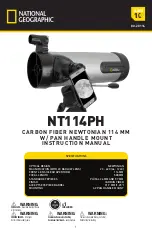
6
f=26 mm
f=9.7 mm
The Moon
f=26 mm
f=9.7 mm
Terrestrial Images
Possible Objects for Observation:
Terrestrial objects
Take note of the examples below, including Mount Rushmore and the golf course.
Start with the 26 mm eyepiece and focus until the image is clear. After mastering
the 26 mm eyepiece, switch to the 9.7 mm eyepiece and practice scanning and
focusing until the image is clear. Choose several terrestrial objects to practice
focusing on, but never point your telescope at or near the sun, or you risk blindness.
The Moon
Diameter: 3,476 km
Distance: Approximately 384,401 km
The Moon is the Earth’s only natural satellite, and it is the second brightest object in
the sky (after the Sun). Although it is our closest neighbor, a lot of people have never
really taken a good long like at the Moon. With your telescope, you should be able to
see several interesting lunar features. These include lunar maria, which appear as
vast plains, and some of the larger craters. The best views will be found along the
terminator, which is the edge where the visible and cloaked portions of the Moon meet.
Orion Nebula (M 42)
M 42 in the Orion constellation
Right ascension: 05:35 (Hours: Minutes)
Declination: -5:22 (Degrees: Minutes)
Distance from Earth: 1,500 light years
Located about 1,500 light years from Earth, the Orion Nebula (Messier 42,
abbreviation: M 42) is the brightest diffuse nebula in the sky – visible with the naked
eye, and a worthwhile object for telescopes of all types and sizes, from the smallest
field glass to the largest earthbound observatories and the Hubble Space Telescope.
When talking about Orion, we‘re actually referring to the main part of a much larger
cloud of hydrogen gas and dust, which spreads out over half of the Orion constellation.
The expanse of this enormous cloud stretches several hundred light years.
Ring Nebula (M 57)
M 57 in the Lyra constellation
Right ascension: 18:53 (Hours: Minutes)
Declination: -33:02 (Degrees: Minutes)
Distance from Earth: 2,400 light years
The famous Ring Nebula M 57 in the constellation of Lyra is often viewed as the
prototype of a planetary nebula; it is one of the magnificent features of the Northern
Hemisphere’s summer sky. Recent studies have shown that it is probably comprised
of a ring (torus) of brightly shining material that surrounds the central star (only
visible with larger telescopes), and not of a gas structure in the form of a sphere or
an ellipsis. If you were to look at the Ring Nebula from the side, it would look like the
Dumbbell Nebula (M27). When viewed from Earth, we are looking directly at the pole
of the nebula.
Dumbbell Nebula (M 27)
M 27 in the Fox constellation
Right ascension: 19:59.6 (Hours: Minutes)
Declination: -+22:43 (Degrees: Minutes)
Distance from Earth: 1,360 light years
The Dumbbell Nebula (M 27) in Fox was the first planetary nebula ever discovered. On
July 12, 1764, Charles Messier discovered this new and fascinating class of objects. We
see this nebula almost directly from its equatorial plane. If we could see the Dumbbell
Nebula from one of its poles, we would see the shape of a ring, and we would see
something very similar to what we know as the Ring Nebula (M 57). In reasonably good
weather, we can see this object well even with low magnifications.
f=26 mm
f=9.7 mm
Orion Nebula M 42
f=26 mm
f=9.7 mm
Ring Nebula in Lyra
Constellation M 57
f=26 mm
f=9.7 mm
Dumbbell Nebula in Fox
Constellation M 27



















